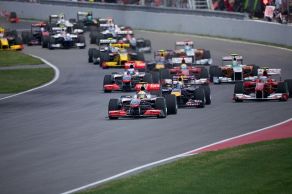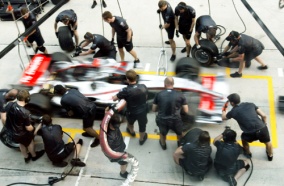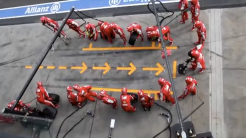What does F1 racing and Lea n Product Development have in common? Not much at the surface… but if you, as I do, see everything as systems then you can’t help but notice some interesting things. In this case I found an apparent counter-example to Lean that is Lean despite going against the grain of traditional Lean Thinking. Hmmm… we’re into double-negatives here but stay with me.
n Product Development have in common? Not much at the surface… but if you, as I do, see everything as systems then you can’t help but notice some interesting things. In this case I found an apparent counter-example to Lean that is Lean despite going against the grain of traditional Lean Thinking. Hmmm… we’re into double-negatives here but stay with me.
The racing analogy is interesting to me not because “Lean=Speed” but because someone questioned the “obvious right way” and came up with a counter-intuitive better solution.
 I am always amazed every time I catch even a glimpse of Formula-1 racing. The cars fly around the track at up to 300 miles per hour, pull 1.45g during acceleration and 4g when braking. High speeds, tight turns and frequent acceleration and braking wears hard on car and driver, but even more so on the tires which aren’t even engineered to last a whole race.
I am always amazed every time I catch even a glimpse of Formula-1 racing. The cars fly around the track at up to 300 miles per hour, pull 1.45g during acceleration and 4g when braking. High speeds, tight turns and frequent acceleration and braking wears hard on car and driver, but even more so on the tires which aren’t even engineered to last a whole race.
An F1 tyre these days is designed to only last for about 120 kilometers on average (it’s a weight vs. durability tradeoff), but most F1 races are at least 305 kilometers long. That means you need to change tires 2 or 3 times in a race that is won or lost by fractions of a second.
I’m fascinated by this, of course, because the pit stop is the biggest impediment to continuous flow around the track. If you could make one less pit stop than your competitor you would be several seconds ahead, turning 10th place into victory. For a long time that was the strategy: go easy around the curves so as to conserve tires and fuel. A lower average speed would win the race as long as you could avoid making too many pit stops. So far it sounds Lean, right? Slow down and you’ll finish the race faster. No surprise there: Lean solutions are usually counter-intuitive.
Twisting and Turning
Well, every good story has a twist and our little F1-Lean analogy is no different.
In the mid-1980s someone took a step back and looked at the whole end-to-end  system and realized that the “economy” of racing could be improved. Start the race with only half a tank of fuel, and the car would be much lighter and go faster. Stop worrying about conserving tires and instead push the car to the limits on the track. The penalty for this strategy is an added number of pit stops.
system and realized that the “economy” of racing could be improved. Start the race with only half a tank of fuel, and the car would be much lighter and go faster. Stop worrying about conserving tires and instead push the car to the limits on the track. The penalty for this strategy is an added number of pit stops.
Not a problem – you just need to minimize the time spent in each pit stop.
It’s a tradeoff curve, as always. If you can continuously reduce the amount of time needed to refuel and swap tires, then at some point down the curve the wear-and-tear vs. pit stop balance will shift.
Now it gets interesting. Because we now have two different models of “good” racing strategy, we have to choose – but how? We have to take a systems view, and make the decisions based on the objective merits of each strategy, not by intuition or personal preference.
Yes but we’re talking about Product Development, right?
You see analogies in Product Development all the time. Whenever there is a bottle-neck in our process we have to decide to either fix/improve the bottle-neck, or try to avoid it. Not all bottle-necks are solvable or even visible. Some are disguised as “the way we always do things here”. Most companies have settled on a particular pattern of which bottle-necks (departments/phases) are reasonable (acceptable as the cost of doing business) and which ones aren’t. Companies that structure the development flow through phases and gates accept the overhead associated with functional departments as “not perfect but the best way to do things”.
Lean Thinkers challenge this view all the time: figure out where the the flow stops and then improve it. Usually it comes down to finding local optimizations and then reducing or eliminating tasks in the name of overall flow. For example, eliminating pit stops so that the race can flow un-interrupted.
And sometimes Lean Thinkers have to challenge themselves, to avoid getting stuck in the “best” Lean solution.
So where did Formula-1 end up?
Have a look at this Ferrari pit stop from 2013. Mid-race refueling is no longer allowed in F1, so now it’s all about how quickly you can get 4 new tires on the car. You can feel the anticipation as you watch the pit crew waiting for the car to arrive.
That pit stop took 2.1 seconds. It’s a huge improvement from the minute-plus pit stops of the early days of F1 in the 1950s. Pit crews spend a lot of time and money to squeeze out every millisecond they can from their process. You can almost visualize a value stream map on the garage wall and the team swarming to find and reduce the next bit of waste from the process.
Is it a fair analogy?
But, many will say, that’s not a fair analogy. Obviously they have a lot of specialized equipment and a huge crew of specialists standing by. This is high-stakes racing and has nothing to do with Lean or product development.
Well that’s the whole point behind this blog post. It’s a classic example of how Lean thinking differs from mass-production thinking. It just manifests itself in a different environment. Speed (and safety) matters in F1, and speed (and safety) matters in Lean.
Systems of systems: Lean Fractals
There is a very direct and obvious application of Lean Thinking and Value Streams to what happens in the pit. If you have seen a Value Stream Map, you can easily understand how that helps weed out waste and inefficiencies in the process flow of safely and quickly changing the tires.
But there is another higher-level system at play, which is includes both the pit stop and the track. This system-of-systems has a different kind of flow economy, working off a different set of aggregated information.
If we ignore the system-of-system effect and blindly apply Lean tools it can lead you astray. Pre-1980s racing solved for Lean flow based on how the costs were incurred back then, i.e. relatively slo w pit stops. Slow down around the track and finish in first place. However the cost of any activity changes over time, and the technology and capability of the pit crew improved such that the basic assumptions behind “the best way to race” had to change.
w pit stops. Slow down around the track and finish in first place. However the cost of any activity changes over time, and the technology and capability of the pit crew improved such that the basic assumptions behind “the best way to race” had to change.
In this case they had to question some long-held beliefs assumptions in order to get to a new level of performance. Similarly we find the biggest improvements hiding in plain sight when we look at our overall product development system and question our traditional way of working. Our world is full of systems-of-systems.
I draw two lessons from the F1-Lean analogy:
Question the Status Quo
The obvious approach isn’t always right, and you won’t see it until you look at the whole end-to-end system. It is counter-intuitive that adding one more time-consuming pit stop to your race will speed things up overall… but it does – up to a point.
Even if you settle on a “best” Lean solution, this might also be a local optimum… keep looking and keep questioning. The journey through solution space is not always a linear one.
Invest in non-mainstream efforts
In order to lean out the value stream you may have to invest and focus on non-mainstream efforts such as tooling and supporting activities. This is the stuff of overhead. It’s hard to justify increasing the overhead cost when the normal pressure is to reduce expenses. But in a Lean system the right overhead isn’t a liability – it’s what enables the mainstream to go fast. The F1 teams had to shift investment away from car and engine design and onto the less-glorious pit crew tools and processes.
The difference is in the kind of overhead: instead of traditional overhead which is needed to manage the waste generated by stitching together the work of separate departments, Lean “overhead” is there to make the value stream flow faster at higher quality.
Yes it’s a fair analogy
To return to the point above, yes the analogy is totally fair. You can usually make your product development progress much faster if you invest in a ncillary processes and tools with an eye towards end-to-end Flow. The Ferrari team in the video clip shows 21 crew members, all working franticly for less than 3 seconds. It takes 3 people per tire to do the job. Wasteful resource utilization? Not if time matters and your objective is to get the car through the pit stop quickly. Sure, we obviously can’t allocate 21-person support teams for all tasks, but the idea is to figure out what it takes to achieve the best end-to-end flow and then invest accordingly.
ncillary processes and tools with an eye towards end-to-end Flow. The Ferrari team in the video clip shows 21 crew members, all working franticly for less than 3 seconds. It takes 3 people per tire to do the job. Wasteful resource utilization? Not if time matters and your objective is to get the car through the pit stop quickly. Sure, we obviously can’t allocate 21-person support teams for all tasks, but the idea is to figure out what it takes to achieve the best end-to-end flow and then invest accordingly.
When I first started developing software we had bi-weekly load builds because it was such a difficult thing to get a clean build with 40 engineers all submitting several weeks of code changes, and build servers were very expensive. We avoided load build “pit stops” until they were absolutely needed.
Gradually the situation changed, and we now have efficient continuous build and test environments and the ability to submit code changes daily. The “economy” of our pit stop changed. It was initially not easy convincing management to invest in extra build servers, tools and staff – but eventually we met the point on the tradeoff-curve where investing in ancillary things like load builds made more and more sense. Now every serious software group has a DevOps setup.
Local vs. Global Optimization
There is a balance between local and global optimizations, and the balance can
shift over time. You can’t even grasp the concept of that balance unless you look at the end-to-end system flow. Chances are that you are only looking at improvements within your own department. If you are, then you might routinely leave improvements of an order of magnitude or more on the table. Look one level up, at the system-of-systems, and see what you can find.